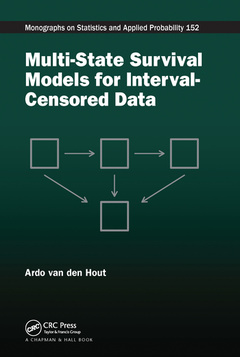Multi-State Survival Models for Interval-Censored Data Chapman & Hall/CRC Monographs on Statistics and Applied Probability Series
Auteur : van den Hout Ardo

Multi-State Survival Models for Interval-Censored Data introduces methods to describe stochastic processes that consist of transitions between states over time. It is targeted at researchers in medical statistics, epidemiology, demography, and social statistics. One of the applications in the book is a three-state process for dementia and survival in the older population. This process is described by an illness-death model with a dementia-free state, a dementia state, and a dead state. Statistical modelling of a multi-state process can investigate potential associations between the risk of moving to the next state and variables such as age, gender, or education. A model can also be used to predict the multi-state process.
The methods are for longitudinal data subject to interval censoring. Depending on the definition of a state, it is possible that the time of the transition into a state is not observed exactly. However, when longitudinal data are available the transition time may be known to lie in the time interval defined by two successive observations. Such an interval-censored observation scheme can be taken into account in the statistical inference.
Multi-state modelling is an elegant combination of statistical inference and the theory of stochastic processes. Multi-State Survival Models for Interval-Censored Data shows that the statistical modelling is versatile and allows for a wide range of applications.
Preface
Introduction
Multi-state survival models
Basic concepts
Examples
Overview of methods and literature
Data used in this book
Modelling Survival Data
Features of survival data and basic terminology
Hazard, density and survivor function
Parametric distributions for time to event data
Regression models for the hazard
Piecewise-constant hazard
Maximum likelihood estimation
Example: survival in the CAV study
Progressive Three-State Survival Model
Features of multi-state data and basic terminology
Parametric models
Regression models for the hazards
Piecewise-constant hazards
Maximum likelihood estimation
A simulation study
Example
General Multi-State Survival Model
Discrete-time Markov process
Continuous-time Markov processes
Hazard regression models for transition intensities
Piecewise-constant hazards
Maximum likelihood estimation
Scoring algorithm
Model comparison
Example
Model validation
Example
Frailty Models
Mixed-effects models and frailty terms
Parametric frailty distributions
Marginal likelihood estimation
Monte-Carlo Expectation-Maximisation algorithm
Example: frailty in ELSA
Non-parametric frailty distribution
Example: frailty in ELSA (continued)
Bayesian Inference for Multi-State Survival Models
Introduction
Gibbs sampler
Deviance Information Criterion (DIC)
Example: frailty in ELSA (continued)
Inference using the BUGS software
Redifual State-Specific Life Expectancy
Introduction
Definitions and data considerations
Computation: integration
Example: a three-state survival process
Computation: micro-simulation
Example: life expectancies in CFAS
Further TopicsDiscrete-time models for continuous-time processes
Using cross-sectional data
Missing state data
Modelling the first observed state
Misclassification of states
Smoothing splines and scoring
Semi-Markov models
Matrix P(t) When Matrix Q is Constant
Two-state models
Three-state models
Models with more than three states
Scoring for the Progressive Three-State Model
Some Code for the R and BUGS Software
General-purpose optimiser
Code for Chapter 2
Code for Chapter 3
Code for Chapter 4
Code for numerical integration
Code for Chapter 6
Bibliography
Index
Ardo van den Hout
Date de parution : 06-2020
15.6x23.4 cm
Date de parution : 11-2016
15.6x23.4 cm
Thèmes de Multi-State Survival Models for Interval-Censored Data :
Mots-clés :
Piecewise Constant Approximation; Interval Censoring; piecewise; Multi-state Model; constant; Gompertz Model; approximation; Living States; dead; Multi-state Process; van; Piecewise Constant Hazard; den; Frailty Model; hout; Transition Probability Matrix; process; Weibull Model; baseline; Dead State; hazards; Baseline Hazard; Survival Model; Frailty Term; Posterior Probabilities; Fixed Effects Model; Scoring Algorithm; Left Truncation; Eigenvalue Decomposition; Gauss Hermite Quadrature; Silverman’s Rule; Ab Ilit; Transition Probabilities; Kernel Density Estimation; Model Ii



